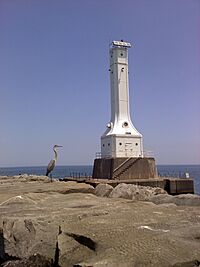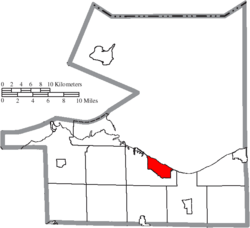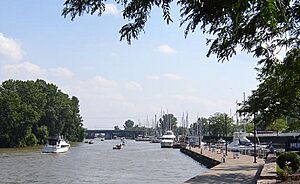Huron, Ohio facts for kids
Quick facts for kids
Huron, Ohio
|
|
|---|---|

Harbor Light in Huron
|
|
| Motto(s):
"A Great Lake Place"
|
|

Location of Huron in Erie County
|
|
| Country | United States |
| State | Ohio |
| County | Erie |
| Government | |
| • Type | Council-manager |
| Area | |
| • Total | 7.91 sq mi (20.48 km2) |
| • Land | 4.94 sq mi (12.80 km2) |
| • Water | 2.96 sq mi (7.67 km2) |
| Elevation | 591 ft (180 m) |
| Population
(2020)
|
|
| • Total | 6,922 |
| • Density | 1,400.36/sq mi (540.65/km2) |
| Time zone | UTC-5 (Eastern (EST)) |
| • Summer (DST) | UTC-4 (EDT) |
| ZIP Codes |
44839
|
| Area code(s) | 419 and 567 |
| FIPS code | 39-37016 |
| GNIS ID | 2394457 |
| Website | http://www.cityofhuron.org/ |
Huron is a city in Erie County, Ohio, United States. It is located where the Huron River meets Lake Erie. In 2020, about 6,922 people lived there. Huron is part of the larger Sandusky area.
Contents
History of Huron
Huron Township was once part of a special area called the "Firelands". This land was set aside for people from Connecticut whose homes were burned during the American Revolutionary War.
The first person to settle permanently in the Huron area was John Baptiste Flammand around 1805. He was a trapper and trader. He set up a trading post near the Huron River. Other French traders had visited the area even earlier.
Early Development
Huron Township was officially created in 1809. The village of Huron itself was started between 1821 and 1824. During this time, the town was mapped out, and port facilities were built. Huron quickly became a major center for building ships in the 1830s.
It's important to know that the Huron we know today is not the same as an older "town plat of Huron." That older town was established around 1814 and was actually in what is now Milan Township.
Railroad and Port Growth
The Wheeling and Lake Erie Railroad helped Huron's port grow a lot starting in 1880. The first shipment of iron ore arrived at the railroad docks in 1884.
The port is still used today. Large lake freighters bring in important materials like iron ore and limestone.
Fishing and Lake Erie
Huron was also home to many commercial fishing boats. However, pollution in Lake Erie severely damaged the fishing industry by the early 1970s.
Since then, strong environmental rules have greatly improved the water quality in Lake Erie. Now, sport fishing is very popular in the area. But the lake still faces new challenges. These include algal blooms (large growths of algae) and invasive species like zebra mussels and Asian carp. These new threats could affect sport fishing in the future.
Geography of Huron

Huron covers a total area of about 7.73 square miles (20.02 square kilometers). Most of this area, about 4.84 square miles (12.54 square kilometers), is land. The rest, about 2.89 square miles (7.49 square kilometers), is water, mainly from the Huron River and Lake Erie.
Population of Huron
| Historical population | |||
|---|---|---|---|
| Census | Pop. | %± | |
| 1840 | 488 | — | |
| 1860 | 802 | — | |
| 1870 | 697 | −13.1% | |
| 1880 | 1,038 | 48.9% | |
| 1890 | 1,380 | 32.9% | |
| 1900 | 1,708 | 23.8% | |
| 1910 | 1,756 | 2.8% | |
| 1920 | 1,703 | −3.0% | |
| 1930 | 1,699 | −0.2% | |
| 1940 | 1,827 | 7.5% | |
| 1950 | 2,515 | 37.7% | |
| 1960 | 5,197 | 106.6% | |
| 1970 | 6,896 | 32.7% | |
| 1980 | 7,123 | 3.3% | |
| 1990 | 7,030 | −1.3% | |
| 2000 | 7,958 | 13.2% | |
| 2010 | 7,149 | −10.2% | |
| 2020 | 6,922 | −3.2% | |
| 2021 (est.) | 6,860 | −4.0% | |
| Sources: | |||
2010 Census Information
In 2010, Huron had 7,149 people living in 3,073 households. About 1,988 of these were families. The city had about 1,477 people per square mile.
Most of the people in Huron were White (96.4%). Other groups included African American (0.9%), Native American (0.3%), and Asian (0.5%). About 2.3% of the population was Hispanic or Latino.
About 29.1% of households had children under 18 living with them. The average household had 2.30 people, and the average family had 2.84 people. The median age in Huron was 43.9 years old.
Economy of Huron
Huron's businesses and industries used to be mainly around the riverfront port. By the early 1960s, downtown Huron was a busy place. It served local people and summer tourists.
However, new roads like U.S. Route 6 and Ohio Route 2 made it easier to travel to bigger cities. This caused downtown Huron to decline.
Urban Renewal and New Downtown
Starting in 1967, the City of Huron began a big project called urban renewal. The city bought many commercial buildings and homes. They then tore them down to build a new downtown area.
The main part of this new area is the Huron Boat Basin. It has become a popular park and meeting place for the community. While the downtown area didn't develop as fast as planned, new businesses and industries have grown in the southern and western parts of the city.
ConAgra Site Transformation
In 2006, the Ohio Department of Natural Resources (ODNR) bought the ConAgra Foods facility in Huron. ConAgra Foods then closed its large grain elevator. This 19.8-acre (80,000 m2) area is a very important part of Huron's waterfront.
The ODNR has built a public boating and fishing area there. It has boat ramps, docks, and parking. The City of Huron now owns the old grain silos and flour mill. They received money to tear down the buildings, which was finished in 2012.
The city plans for this area to become a new riverfront development. It might include restaurants, shops, and green spaces. In 2012, much of the old ConAgra mill was taken down by implosion. This was a public event that many people watched.
Education in Huron
Huron has a good school system for its students.
Primary and Secondary Schools
The Huron City School District has three main schools:
- Woodlands Elementary School (for younger students)
- McCormick Junior High School (for middle school students)
- Huron High School (for older students)
The sports teams at Huron City Schools are called the "Tigers." They have had many successes in different sports.
Higher Education
BGSU Firelands is a branch campus of Bowling Green State University. It is located just west of Huron. BGSU Firelands has been a regional campus since 1968. In 2006, over 2,000 students were enrolled there. They could study for many different college degrees.
Huron was also home to the "Huron Playhouse." This was once part of Bowling Green State University's theater department. It later became its own independent group.
See also
 In Spanish: Huron (Ohio) para niños
In Spanish: Huron (Ohio) para niños



